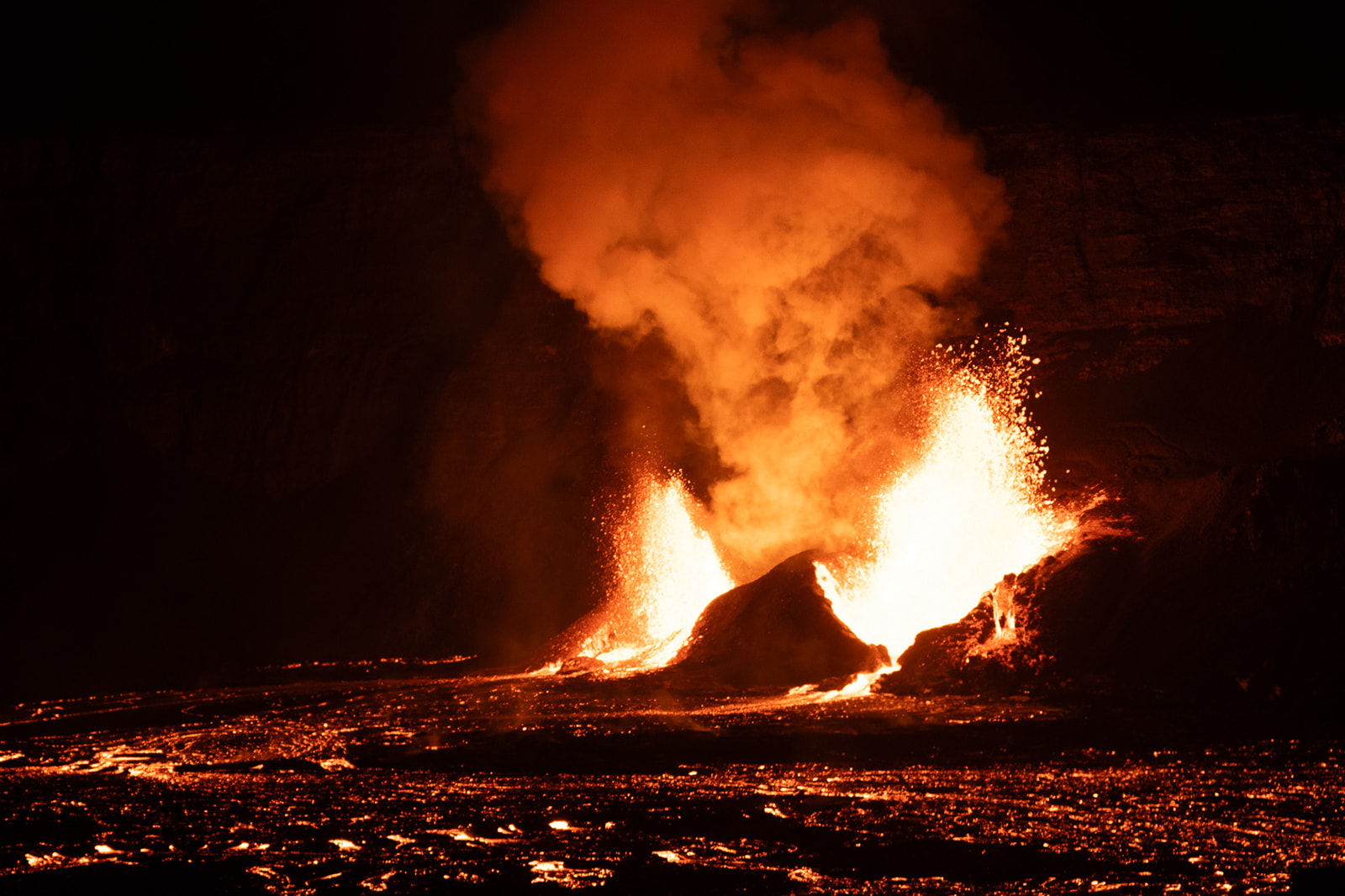Hawaii Wedding and Portrait Photographer on The Big Island, Oahu, Maui, and Kauai.
My team and I can't wait to work with you. Book a session with us to capture your most beautiful Hawaii memories.
the big island adventure guide
Download it hereHawaii Volcanoes National Park: Best Photo Spots And Things To Do
CATEGORY
Date Posted
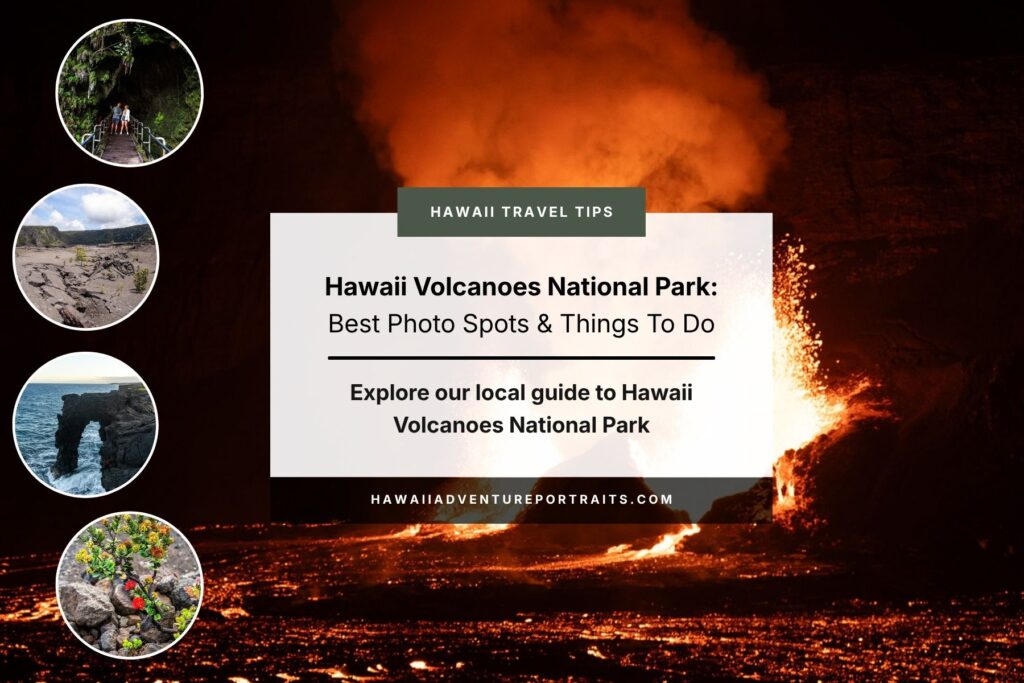
Discover Hawaii Volcanoes National Park: Itinerary and Must-See Spots
If you’re looking for the best Hawaii Volcanoes National Park itinerary and things to do, this guide will help you make the most of your visit. Whether you’re visiting for a day or exploring the island for a week, this guide highlights our favorite locations. From glowing craters to lush lava tubes, we’ve mapped out a one-day plan that combines the park’s top attractions with unforgettable photo spots.
As adventurous Big Island portrait photographers, we love exploring Hawaii’s landscapes when we’re not photographing clients or editing galleries. Volcanoes National Park has an energy that keeps drawing us back. It’s one of our favorite places to find inspiration and reconnect with nature.
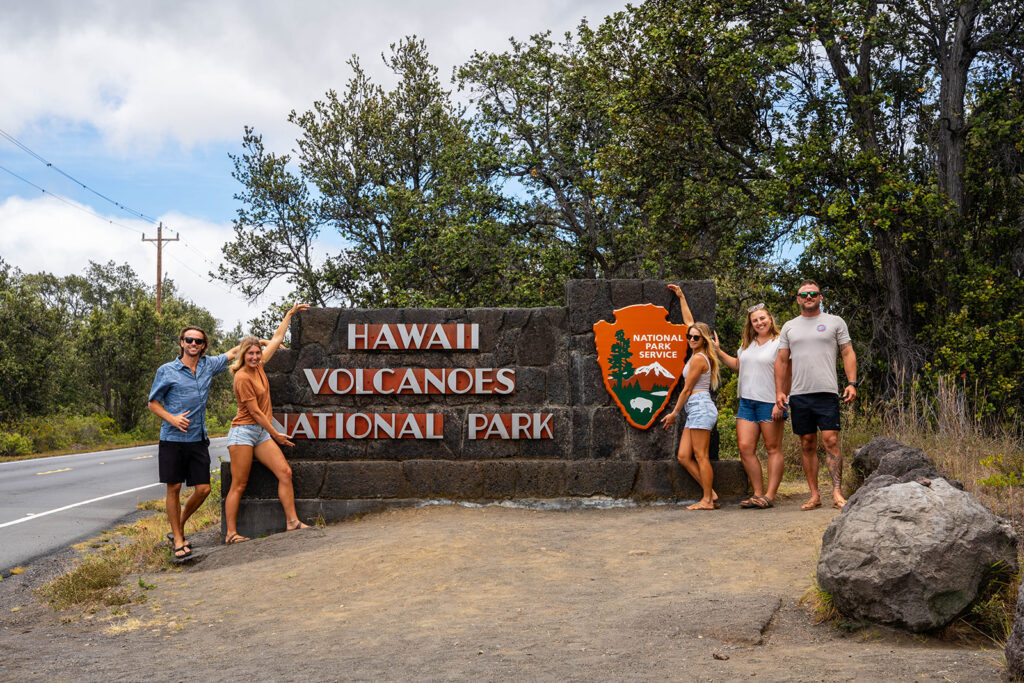
One-Day Hawaii Volcanoes National Park Itinerary and Guide
This one-day itinerary highlights the most memorable things to do for travelers who want to experience the park’s natural wonders, cultural history, and scenic lookouts in one trip.
How to Get to Volcanoes National Park
- From Kona: The drive is about 96 miles and takes around 2 hours when you follow Highway 11 along the southern coast. This route feels relaxed and scenic, with open roads, ocean views, and small towns to stop in along the way. It’s the best option if you want an easy, enjoyable drive straight to the park. Make sure to check out our other guide: Best Volcanoes National Park Day Trip from Kona | Avoid Traffic + Discover Local Stops
- From Hilo: The park is about 30 miles southwest of Hilo and takes roughly 45 minutes on Highway 11. This route is quick and convenient, although it can slow down during peak season. Leaving early in the day gives you a smoother trip and more time to explore the park.
Full Day Recommended Things To Do
You can see all of the park’s locations in one day with an early start time (9 AM).
- Kilauea Visitor Center
- Haʻakulamanu Sulphur Banks
- Steam Vents
- Kilauea Overlook
- Halema‘uma‘u Trail
- Lunch Break
- Kilauea Iki Trail
- Thurston Lava Tube
- Chain of Craters Road
- Hōlei Sea Arch
- Puʻuloa Petroglyphs
- Halemaʻumaʻu Crater
Half Day Recommended Things To Do
Visit the park’s top highlights in a half day with a more relaxed route and a later start time (12 PM).
- Kilauea Visitor Center
- Kilauea Iki Trail
- Thurston Lava Tube
- Chain of Craters Road
- Hōlei Sea Arch
- Halemaʻumaʻu Crater
Morning: Start Your Day at the Summit
Stop at Kīlauea Visitor Center
Begin your morning at the visitor center to check eruption updates, grab a map, and plan your route. Rangers can answer questions and help you create a Hawaii volcano itinerary that fits your time and interests.
Walk to Kīlauea Overlook
Just a short walk from the Visitor Center, Kīlauea Overlook offers one of the most breathtaking views in Hawaii Volcanoes National Park. From here, you can look across the vast Kīlauea Caldera and see the steaming Halemaʻumaʻu Crater below. It’s an easy and accessible stop that gives you a panoramic view of the park’s volcanic landscape and a true sense of its power.
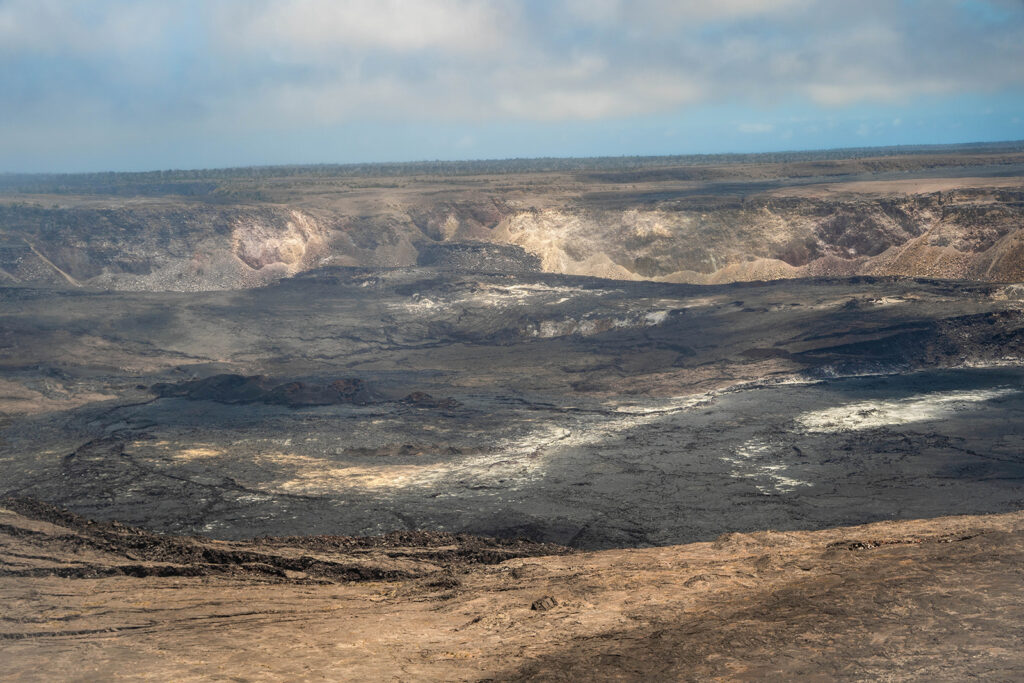
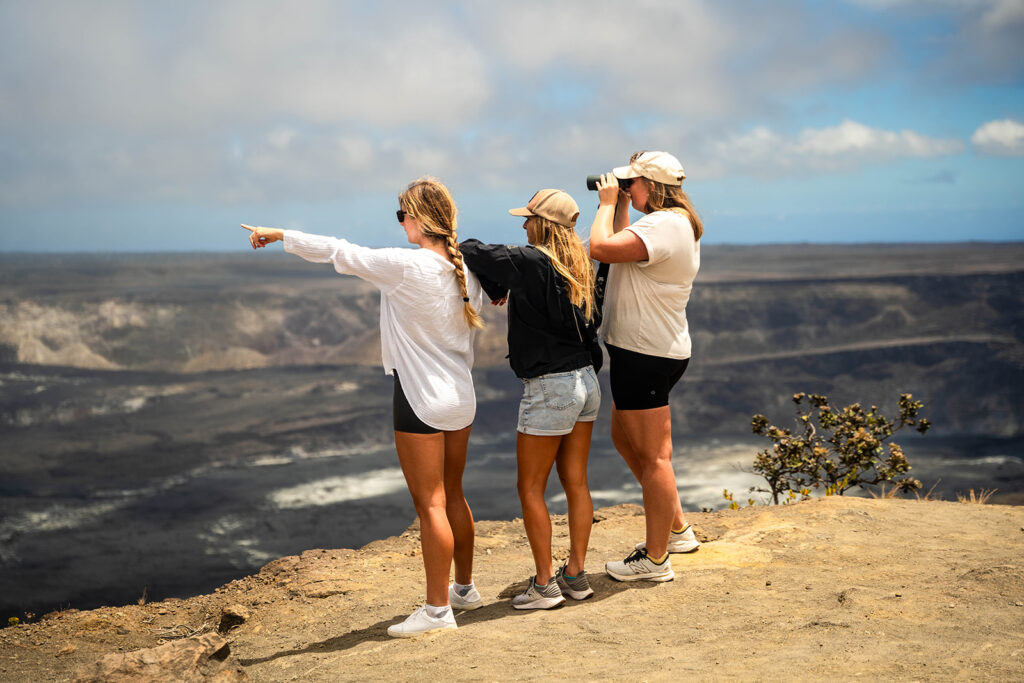
You can also see the Sulphur Banks (Haʻakulamanu) and Steam Vents (Wahinekapu) along the same walking path from the Visitor Center.
- Haakulamanu Sulphur Banks:
Just beyond the Visitor Center, the Sulphur Banks Trail takes you through a landscape filled with geothermal energy. Steam and volcanic gases rise through cracks in the earth, leaving colorful mineral deposits in shades of yellow, red, and orange. The combination of heat, color, and the scent of sulfur makes it an unforgettable stop within the park.
- Steam Vents (Wahinekapu):
Located just past the Kilauea Visitor Center, the Steam Vents offer a fascinating glimpse of volcanic heat escaping through the earth. Rainwater seeps down, meets the hot rock below, and rises back up as visible vapor. Gentle plumes drift across the grassy caldera rim, surrounded by native plants and open views of the volcano.
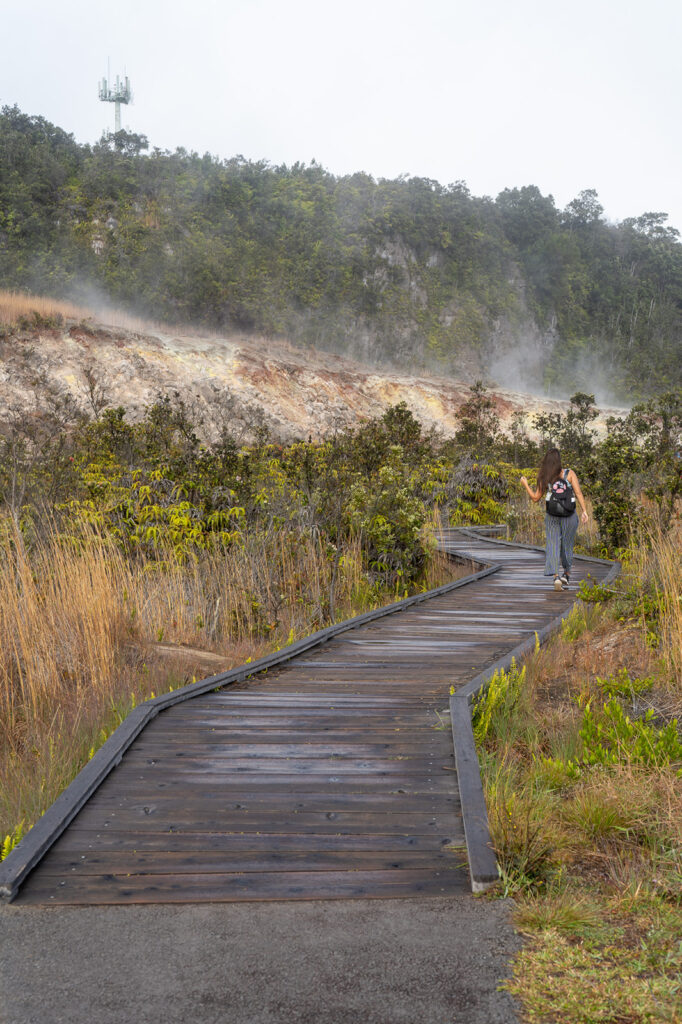
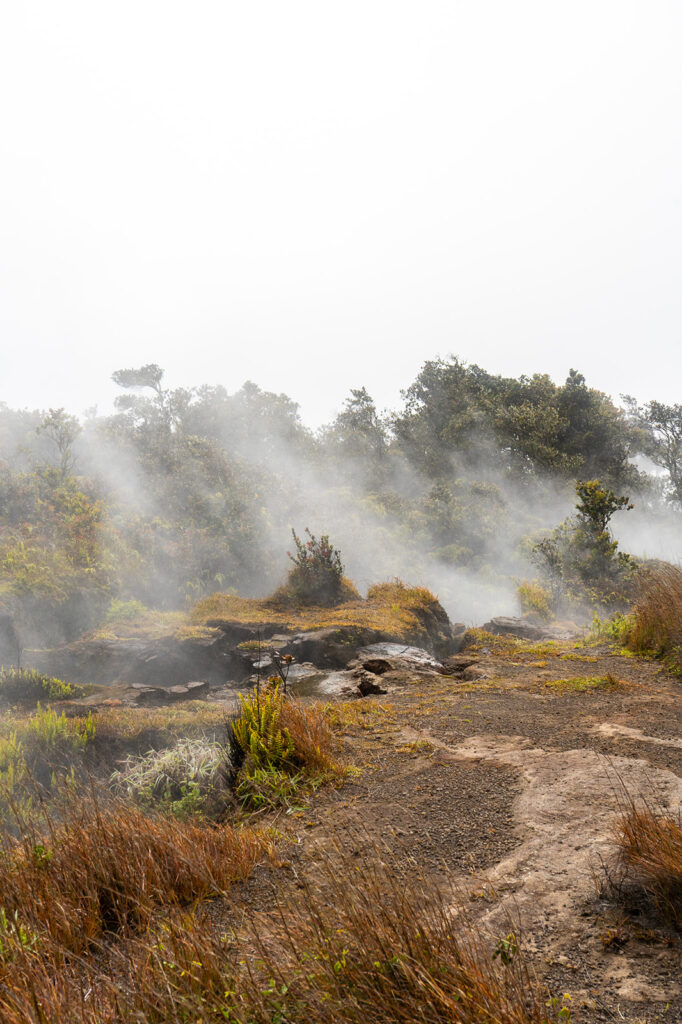
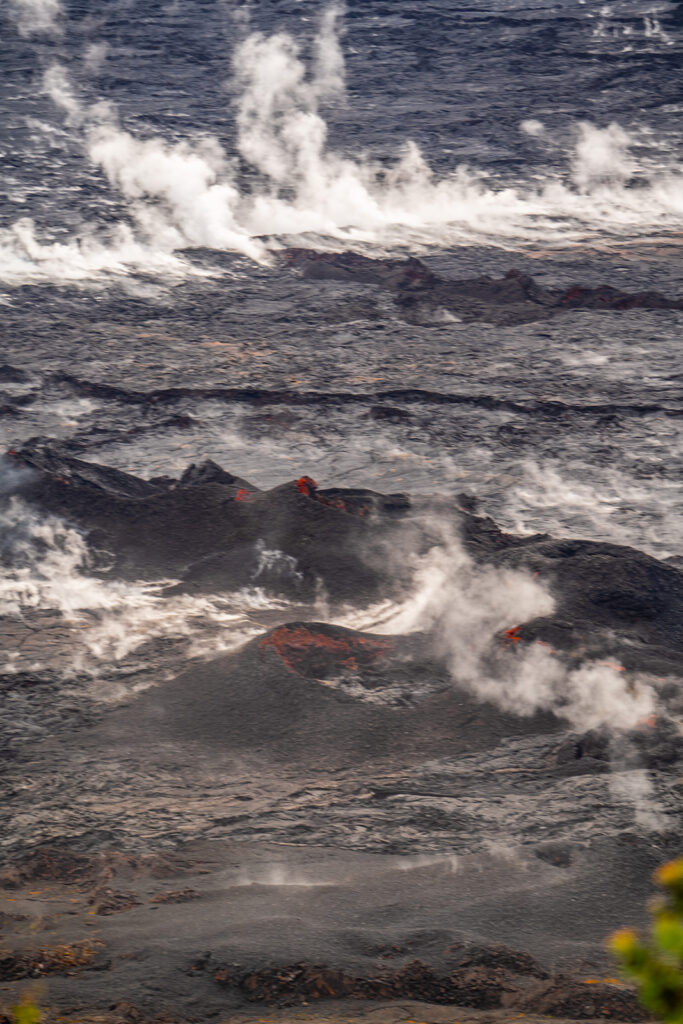
Halema‘uma‘u Trail
The Halema‘uma‘u Trail offers an unforgettable journey through the heart of Kīlauea’s dynamic landscape, descending from the rim of the caldera into a lush rainforest before opening up to sweeping views of the crater below. Along the way, visitors can see evidence of past eruptions and the park’s ongoing regeneration as native plants reclaim the lava-covered terrain. For those looking to deepen their experience, the National Park Service offers ranger-led guided hikes that share insights into the area’s geology, ecology, and cultural significance, providing a fascinating look into the living history of Hawai‘i Volcanoes National Park.
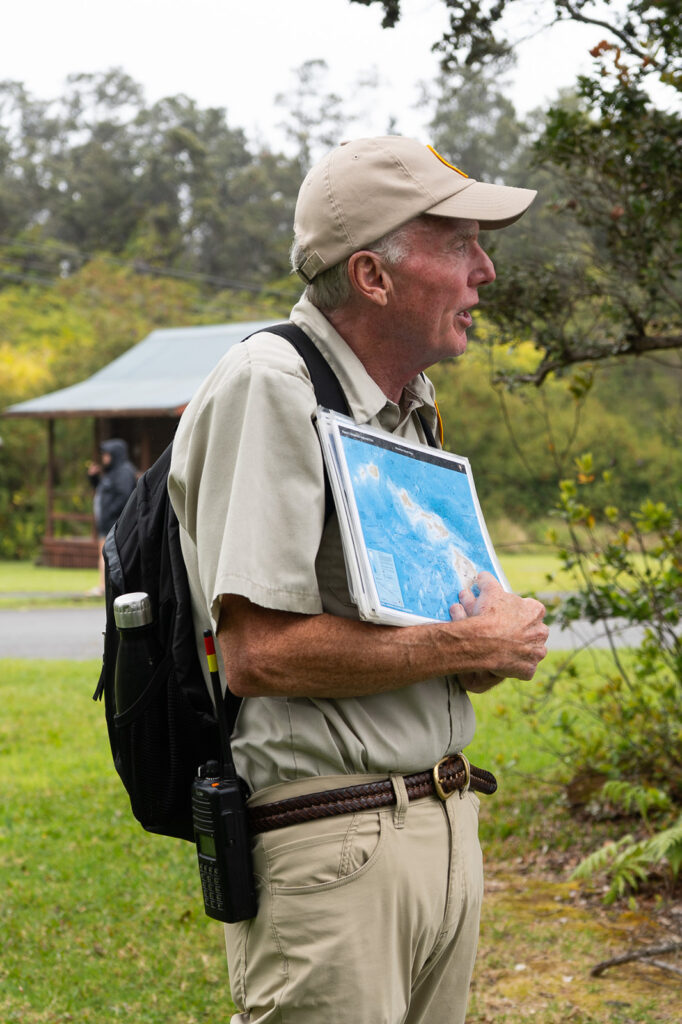
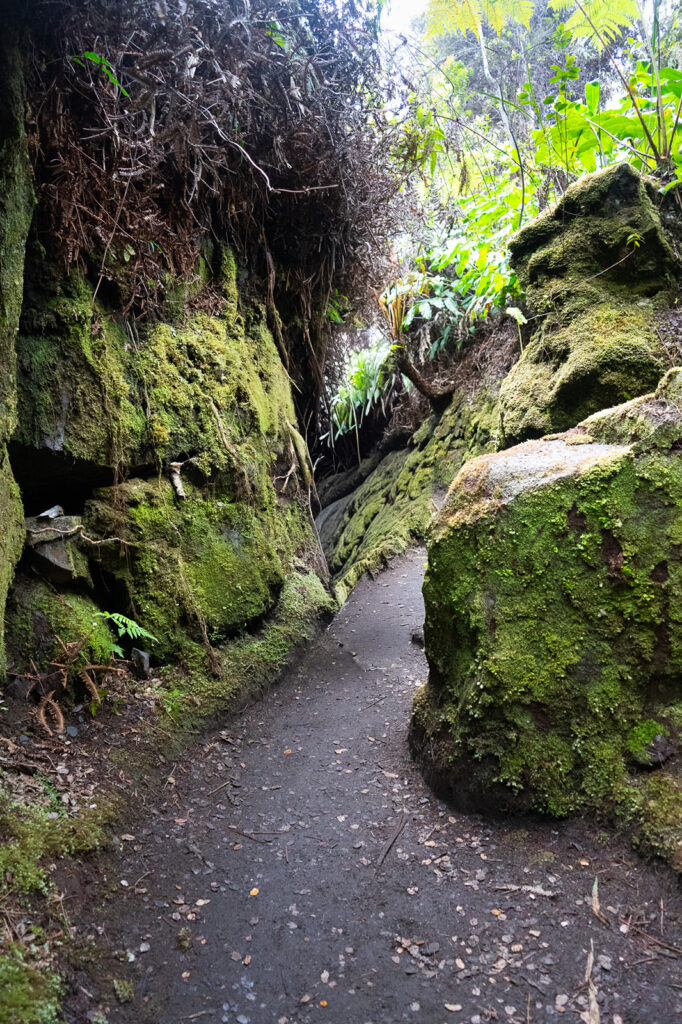
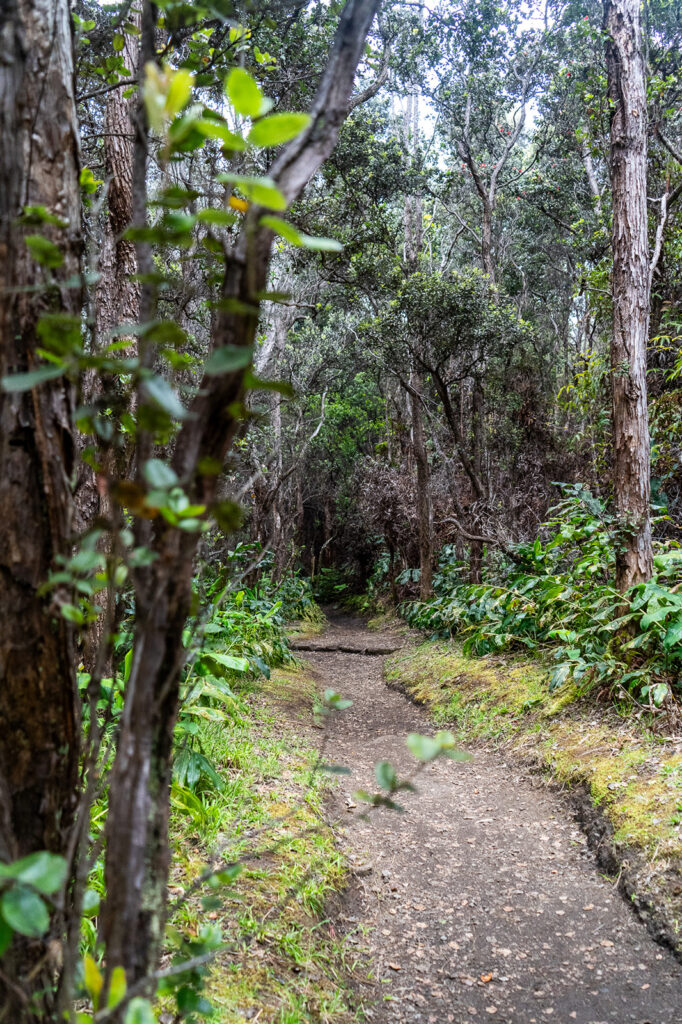
Midday: Lunch Break, Crater Trails and Scenic Views
Lunch Break in Volcano Village
Recharge at one of the small cafés in Volcano Village, or enjoy a picnic near the visitor center. The village is a great place to relax and try local food before continuing your afternoon adventures.
Kīlauea Iki Overlook and Trail
The Kīlauea Iki Trail is one of the most breathtaking hikes in Hawaii Volcanoes National Park, offering a rare chance to walk across a solidified lava lake from the dramatic 1959 eruption. The four-mile loop begins in a lush rainforest filled with native birds and ferns before descending 400 feet into the vast, otherworldly crater floor. As you walk across the hardened lava, you’ll see steam rising from cracks in the ground and vibrant ohia trees and lehua blossoms pushing through the rock. It’s a moderate hike that perfectly blends adventure, scenery, and cultural significance, making it a must-see for anyone exploring the park.
To make the most of your hike, park at the Kīlauea Iki Overlook parking lot and follow the trail north of the lot down into the crater. This route is easier since the steep stairs are much more manageable going down than up. The hike takes you across the crater floor, where you’ll walk among solidified lava flows and steam vents surrounded by native forest. When you emerge on the other side of the Kīlauea Iki Trail, it’s just a short, easy walk over to Nāhuku (Thurston Lava Tube). Parking near the lava tube is very limited, and the road is narrow with few turnaround spots, which is why we recommend starting your hike from the Kīlauea Iki parking lot instead.
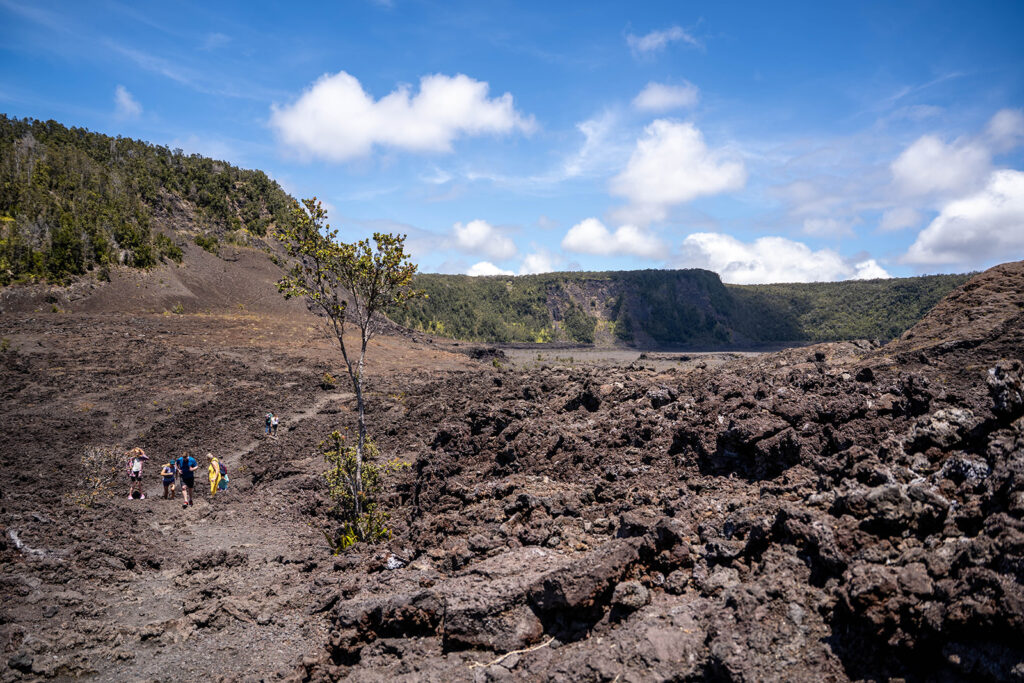
Explore Nāhuku (Thurston Lava Tube): This short rainforest walk takes you through a naturally formed lava tunnel. It’s one of the most family-friendly stops on your Hawaii volcano itinerary and a great place for photos before the crowds arrive.
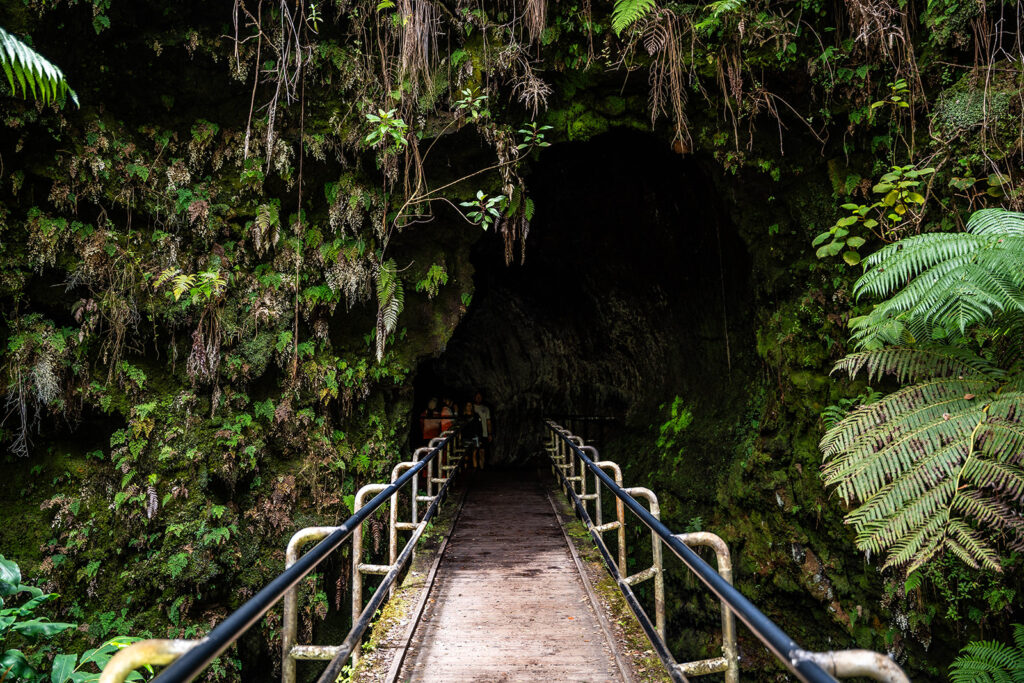
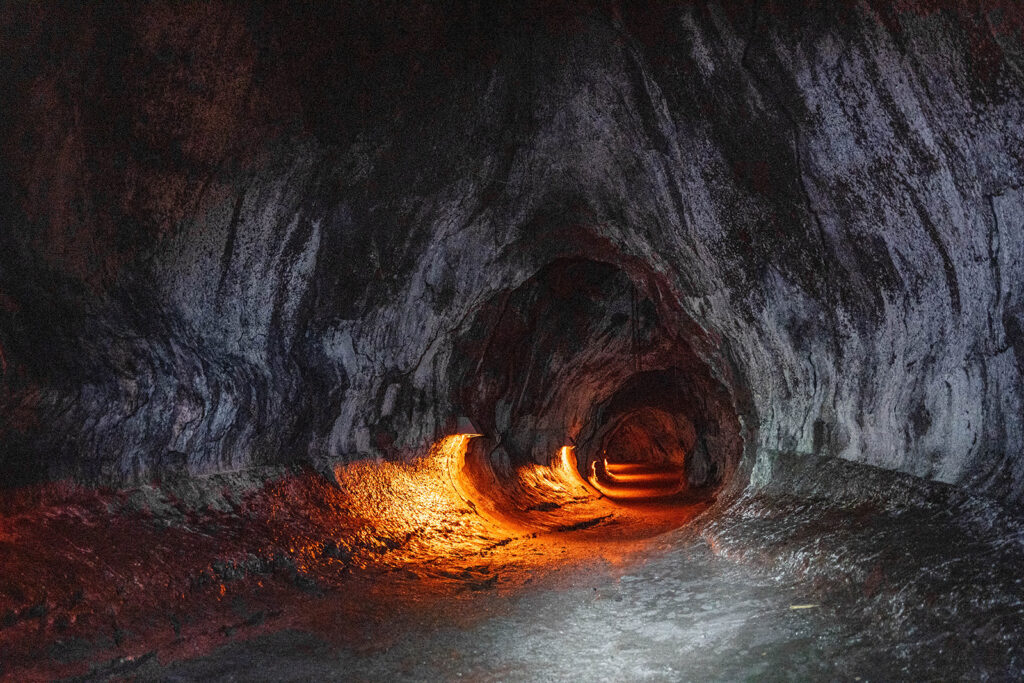
Afternoon: Explore the Coastline and Petroglyphs
This part of your Hawaii Volcanoes National Park itinerary takes you along the dramatic coastline, where lava meets the ocean. It’s one of the most scenic drives on the island and a must for photography lovers.
Drive Chain of Craters Road
This scenic drive is one of the best Hawaii Volcanoes National Park things to do. It winds from lush rainforest to vast lava plains, with plenty of lookouts for photos and short hikes.
Puʻuloa Petroglyphs
Take the short trail to see more than 20,000 ancient Hawaiian rock carvings. The path winds through a field of hardened lava and opens to one of the largest petroglyph sites in Hawaii. Visit in the late afternoon for the best light. This sacred spot adds a cultural highlight to your Hawaii volcano guide.
Hōlei Sea Arch
At the end of Chain of Craters Road, you’ll find the Hōlei Sea Arch, a massive lava formation shaped by the ocean. The contrast of black rock and turquoise waves makes it one of the most photographed views in Hawaii Volcanoes National Park.


Evening: Catch the Glow at Halemaʻumaʻu Crater
Halemaʻumaʻu Crater is one of the most awe-inspiring places to end your day in Hawaii Volcanoes National Park. This active volcanic crater, located within the Kīlauea Caldera, glows with fiery light when volcanic activity is present, creating an unforgettable sight that illuminates the clouds and sky above. Even during calm periods, the mist and twilight colors create a surreal, peaceful scene that perfectly captures the park’s natural power and beauty.
The crater can be reached by parking at the Devastation Trail Parking Lot, and following the Crater Rim Drive path to the viewing area. Stay a little longer after sunset if the skies are clear, as the park’s high elevation and lack of light pollution make it one of the best spots for stargazing on the Big Island.
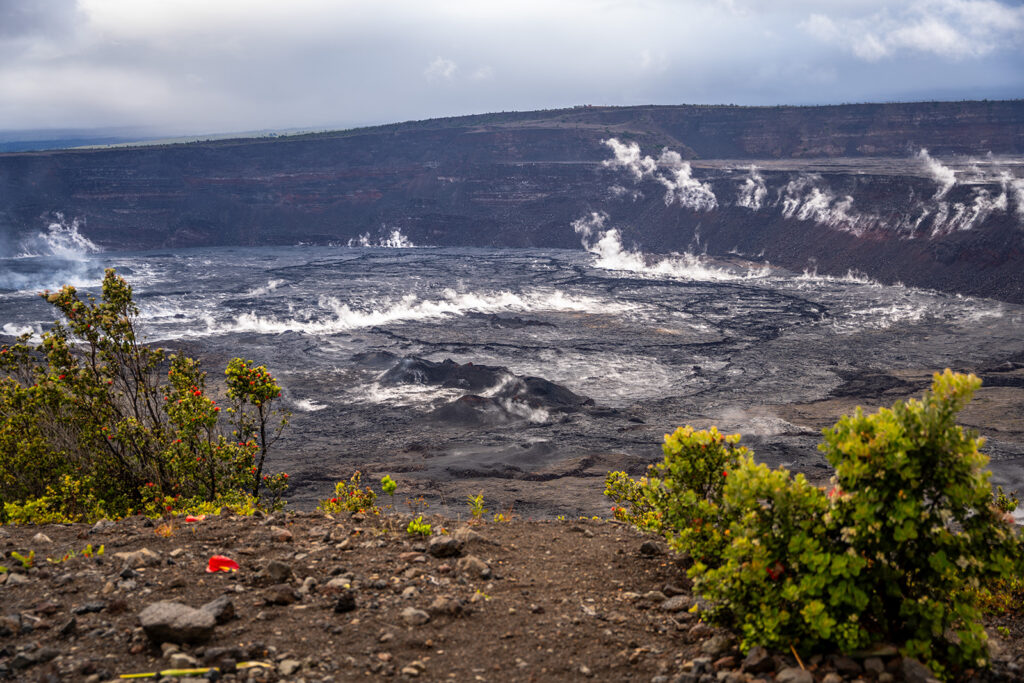
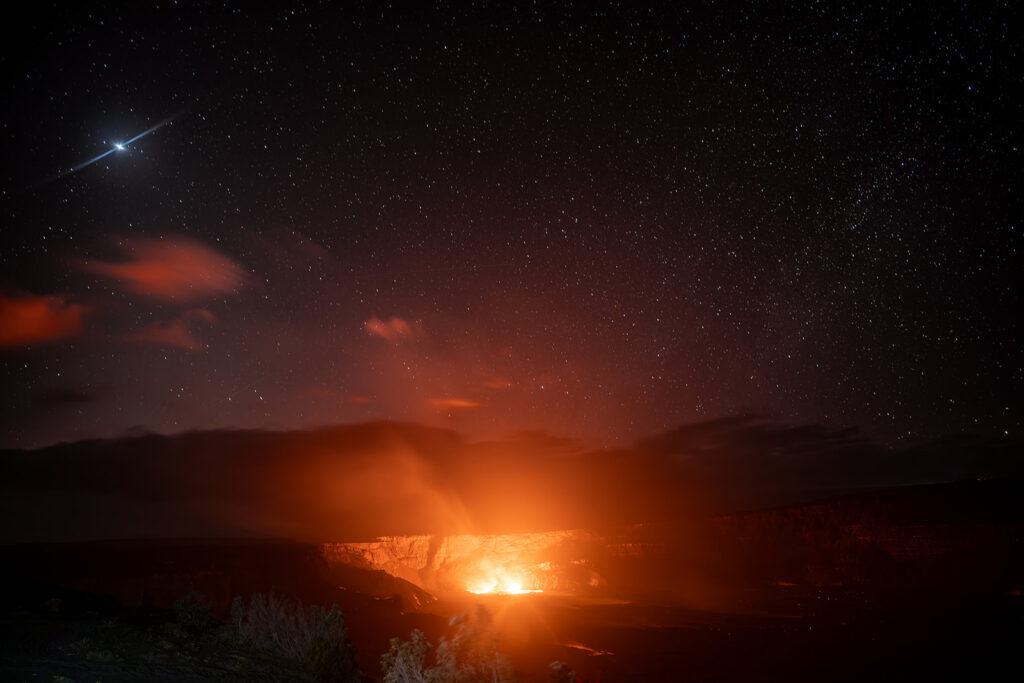
Legends and Wildlife at Hawaii Volcanoes National Park
The Legend of ʻOhiʻa and Lehua
One of the most meaningful Hawaiian legends you will discover during your visit is the story of ʻŌhiʻa and Lehua. It is deeply connected to the landscape and the native ʻŌhiʻa tree, one of the first plants to grow after a lava flow. You can see these trees blooming with red Lehua blossoms throughout Hawaii Volcanoes National Park.
According to Hawaiian tradition, ʻŌhiʻa was a brave warrior and Lehua was his devoted lover. The goddess Pele admired ʻŌhiʻa’s strength and wanted him for herself, but he refused her. Heartbroken and angry, Pele turned him into a twisted tree. The gods took pity on Lehua and transformed her into the tree’s red flower so she and ʻŌhiʻa would always remain together. When it rains after someone picks a Lehua blossom, locals say it is Lehua’s tears, symbolizing love, loss, and reunion.
This story captures the beauty and emotion of Hawaii’s volcanic landscape. It reminds us that even in a place born of fire, life and love always return.
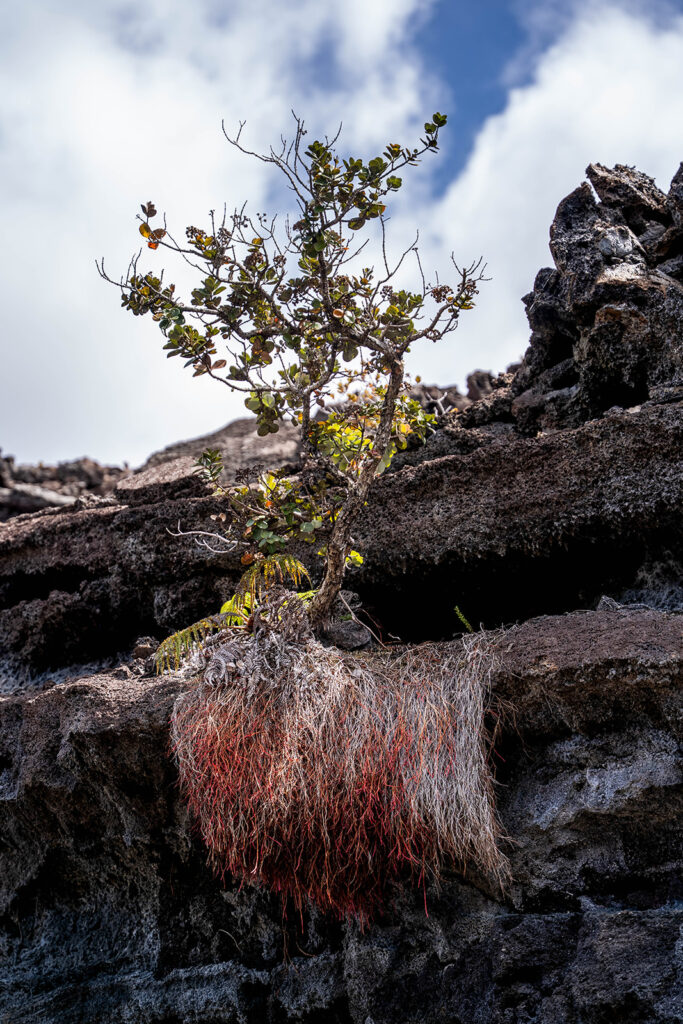
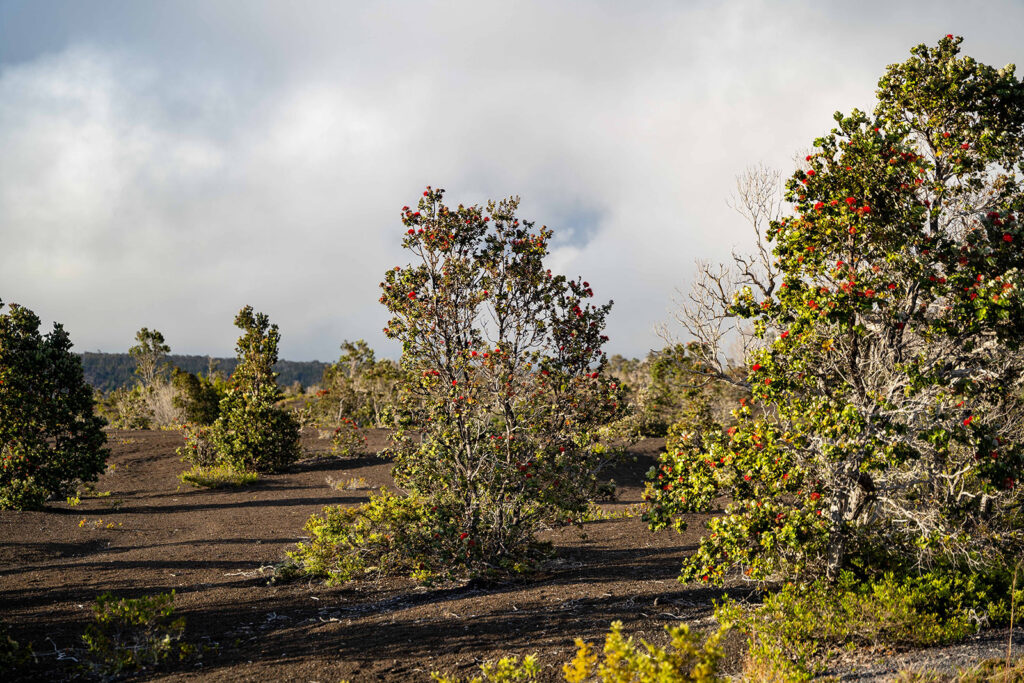
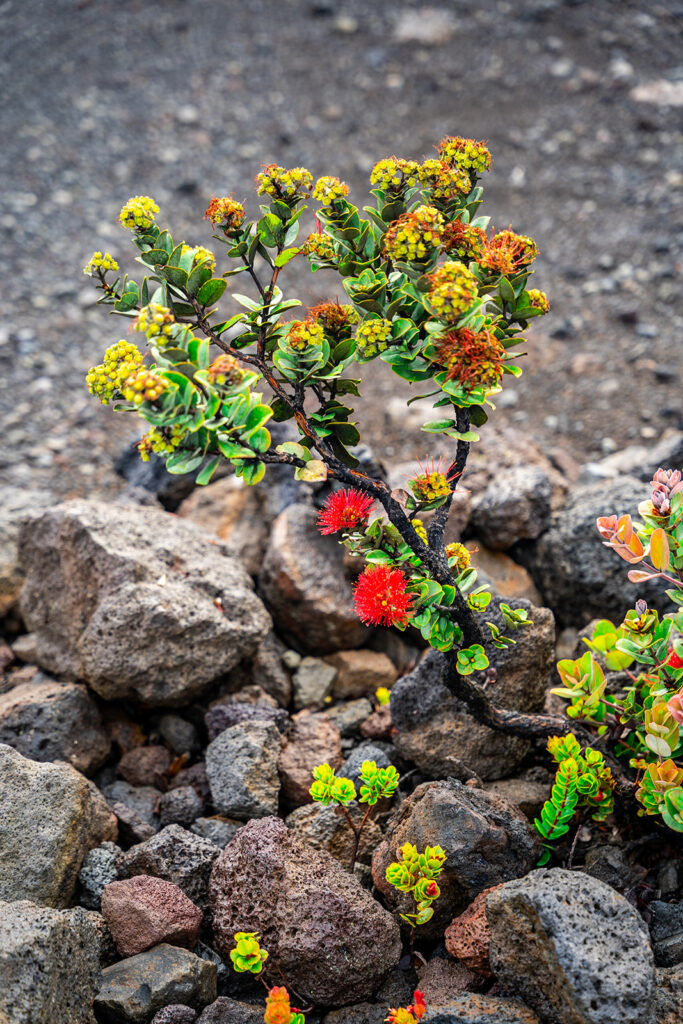
Birdwatching at Hawaii Volcanoes National Park
Birdwatching in Hawaii Volcanoes National Park offers a rare chance to see species found nowhere else on Earth. The park’s diverse landscapes, from lush rainforests to volcanic slopes, create habitats that attract both native and migratory birds. Early morning is the best time to listen for their songs echoing through the forest and spot flashes of color among the trees. See a full list of Native Hawaiian birds here.
ʻApapane
The ʻApapane is a small, bright red honeycreeper often seen feeding on the nectar of ʻōhiʻa lehua blossoms. Its vivid feathers and melodic chirps make it one of the park’s most delightful native birds.
Nēnē (Hawaiian Goose)
The Nēnē, Hawaii’s state bird, is a graceful goose that thrives in volcanic grasslands. Once endangered, it has made a remarkable recovery and can often be spotted near open fields or along park roads.
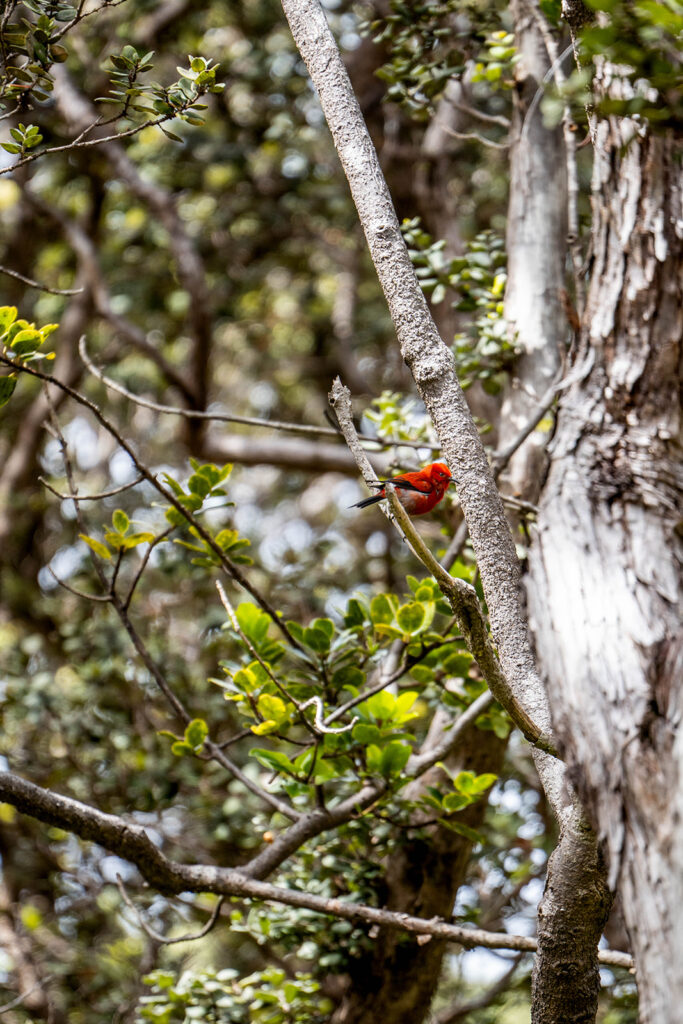
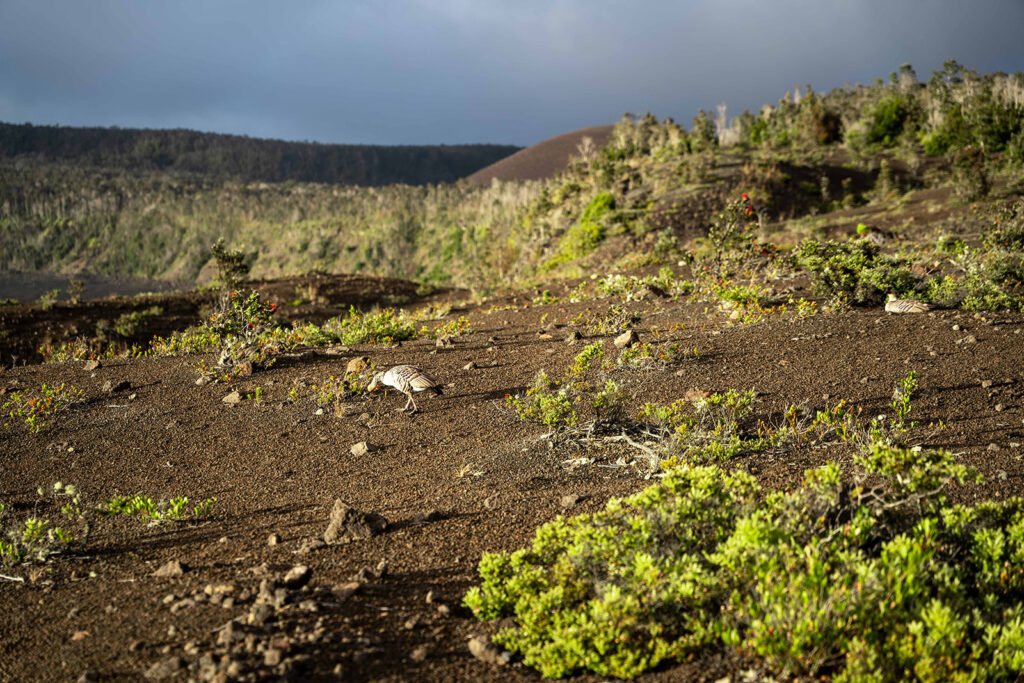
Our Favorite Photo Spots in Hawaii Volcanoes National Park
Every part of the park is worth photographing, but two locations stand out above the rest: Kīlauea Iki Trail and Halemaʻumaʻu Crater. These places capture both the wild energy and natural beauty that make Hawaii Volcanoes National Park so unforgettable.
Kīlauea Iki Trail
This four-mile loop is one of the most rewarding hikes in the park and a dream for photographers. It begins in a lush rainforest before descending onto the hardened surface of a lava lake that erupted in 1959. Steam rises from cracks in the ground and light changes throughout the day. If you are following a Hawaii Volcanoes National Park itinerary, this trail combines adventure with stunning scenery.
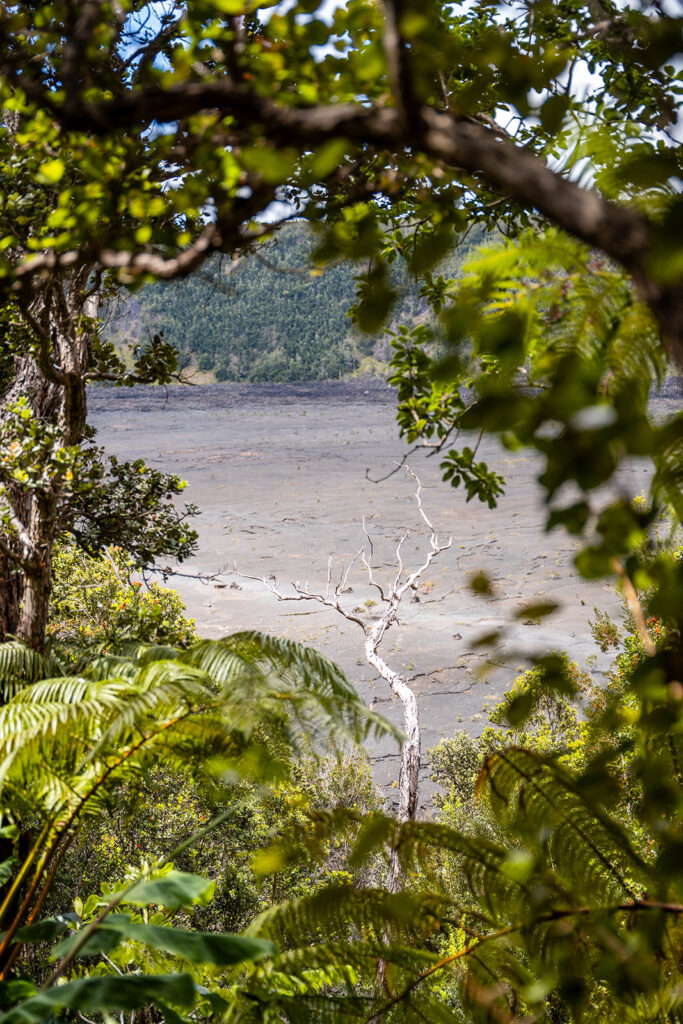
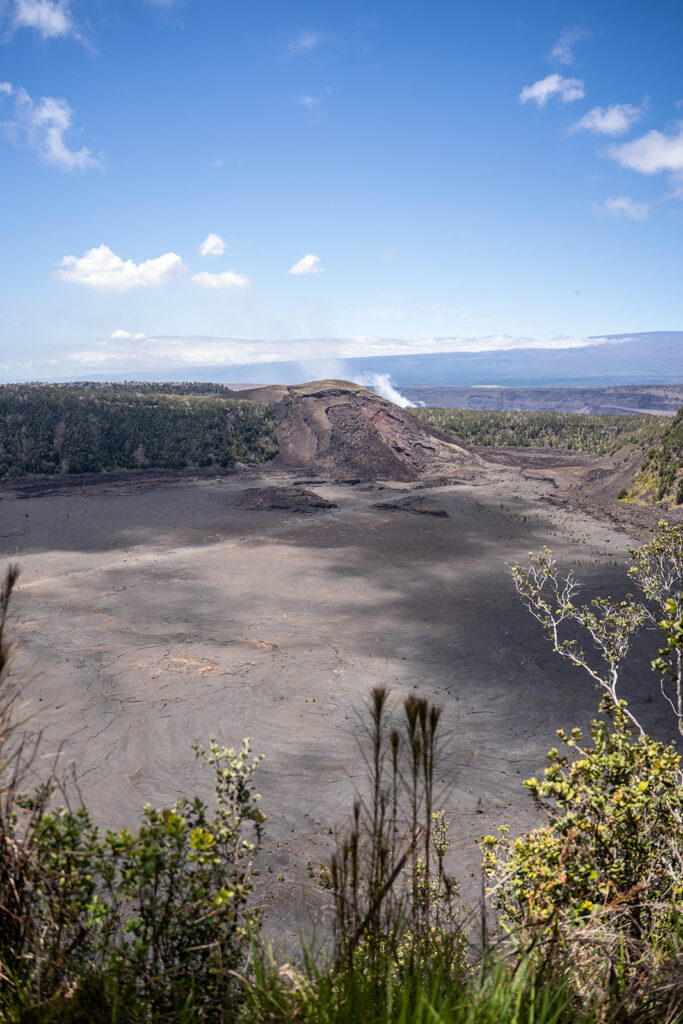
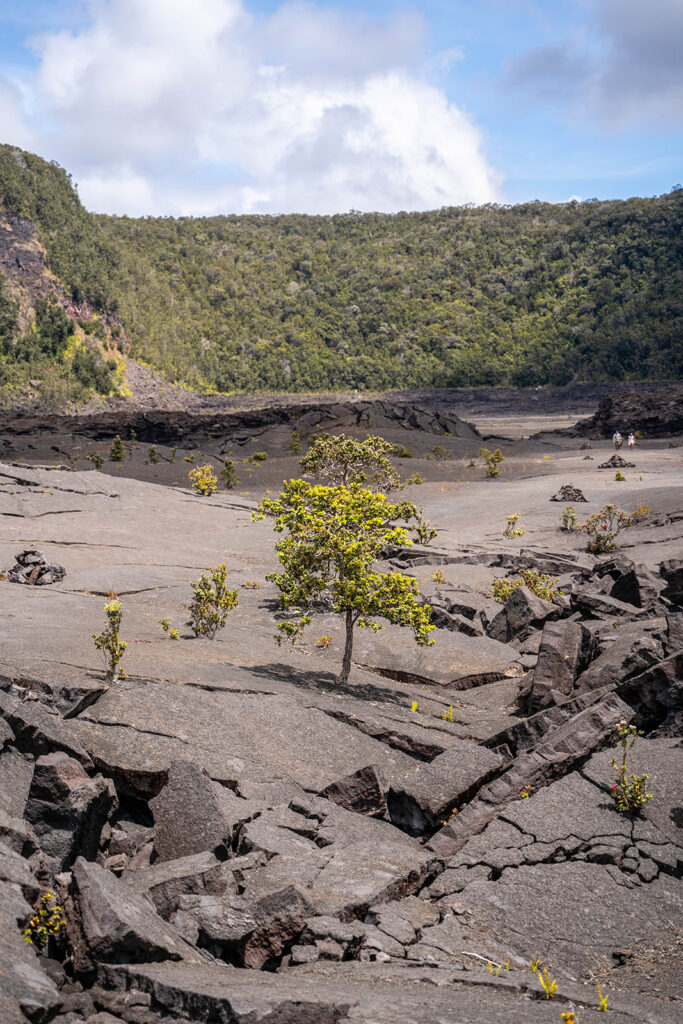
Halemaʻumaʻu Crater
Halemaʻumaʻu is the heart of Kīlauea and one of the most breathtaking viewpoints on the island. The overlook near the visitor center offers a wide view of the crater’s scale and color. When volcanic activity is visible, glowing clouds at dusk make the scene extraordinary. Even on calm days, the patterns of rock and steam make this one of the most photogenic spots in Hawaii Volcanoes National Park.
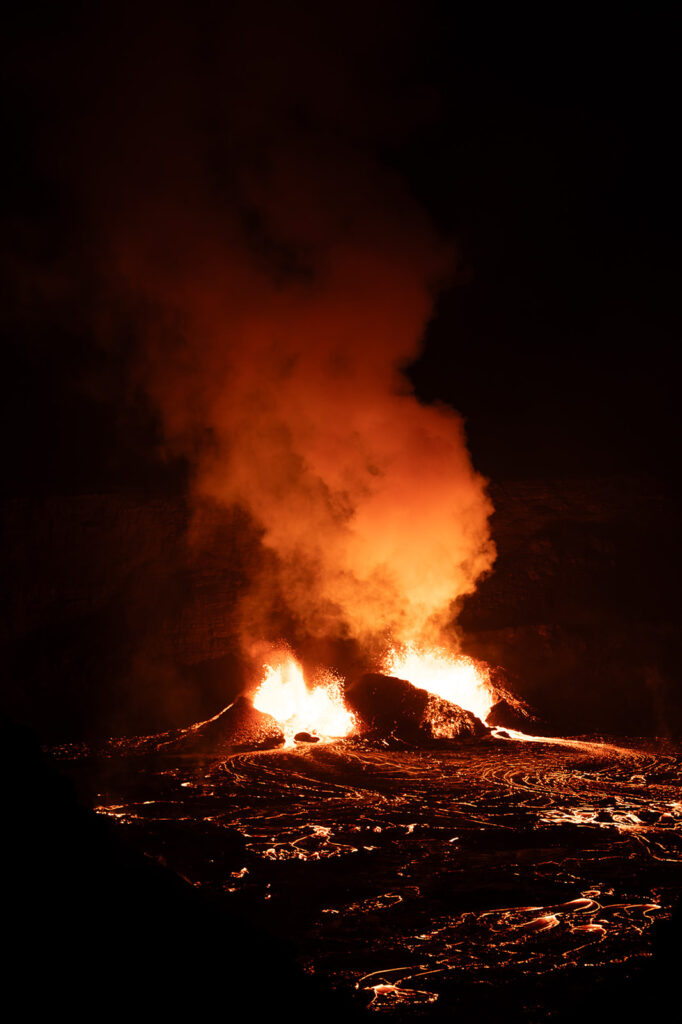
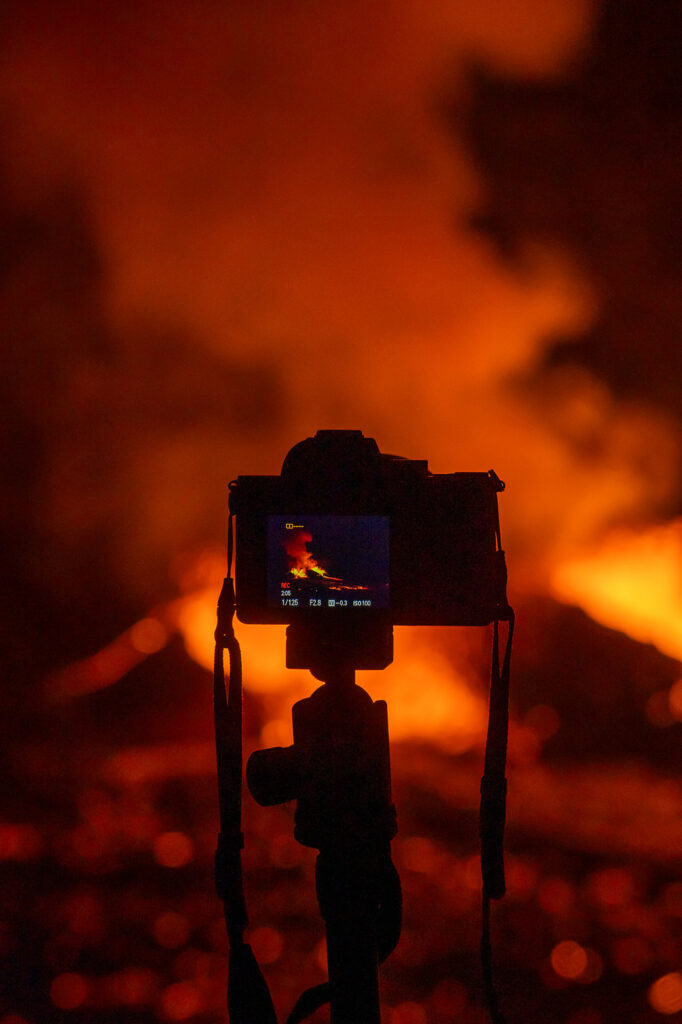
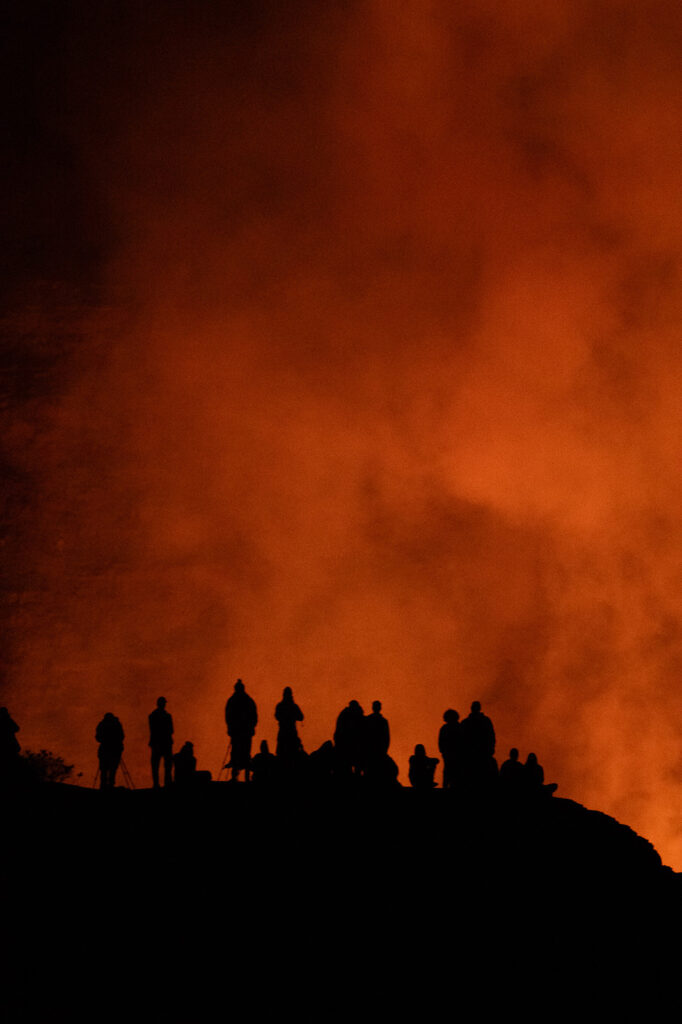
Plan Your Visit to Hawaii Volcanoes National Park
Before visiting, check for current conditions, eruption updates, and closures. This ensures you get the best experience from your Hawaii Volcanoes National Park itinerary.
Helpful Links:
- Visit the Official Hawaii Volcanoes National Park Website
@hawaiivolcanoesnps for official park updates
@808hiker for local hikes and island inspiration
Download Our Big Island Adventure Guide
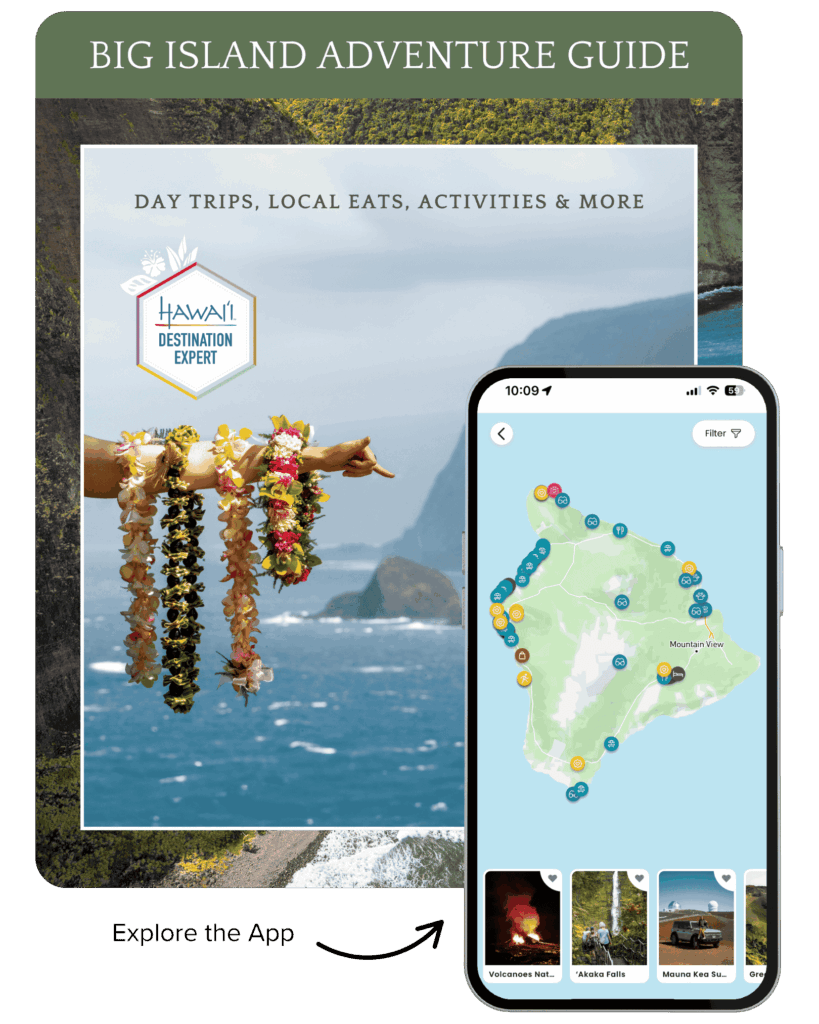
Exploring Hawaii Volcanoes National Park is just the beginning of what the Big Island has to offer. After finishing your list of Hawaii Volcanoes National Park things to do, explore more of Hawaii’s beaches, waterfalls, and scenic drives.
If you want insider tips, favorite local spots, and photography inspiration, download our free Big Island Adventure Guide. It is full of ideas to help you plan an unforgettable trip.
Frequently Asked Questions About Hawaii Volcanoes National Park
We’ve answered a few common questions to help you plan your Hawaii Volcanoes National Park visit and know exactly what to expect.
What is the best time to visit Hawaii Volcanoes National Park?
How long should I spend at Hawaii Volcanoes National Park?
How long does it take to drive from Kona to Volcanoes National Park?
What time should I leave Kona for a Volcanoes National Park day trip?
Can I visit Volcanoes National Park and return to Kona in one day?
Weather in Hawaii Volcanoes National Park
What should I wear in the park?
What should I pack for the drive and park visit?
Can you see lava right now?
Is it safe to visit active volcanic areas?
Do I need a reservation?
Navigation and Maps
Bathrooms and Food Near the Park
Where can I eat near the park?
Parking and Entrance Fees
Is Hawaii Volcanoes National Park family-friendly?
Can I fly a drone in the park?
Where should I stay near Hawaii Volcanoes National Park?
Accessibility and Respect for the Land
What if I prefer not to drive to Volcanoes National Park?
Capture Your Big Island Adventure

If exploring Hawaii Volcanoes National Park inspires you to capture your own Hawaii story, we would love to help. At Hawaii Adventure Portraits, we create photo sessions that reflect your journey with natural light, vibrant colors, and genuine emotion.
Whether you’re traveling as a couple, family, or solo explorer, we can plan a photo session that fits your itinerary. From black sand beaches to palm-lined cliffs and golden sunsets, we will help you preserve the beauty of your adventure.
We’d Love to Help You Plan A Hawaii Family or Couples Photo Session!
If you would like to book a session during your trip, fill out the form below. We will reply within 24 hours to confirm availability and share a link to reserve your date.
If you found this blog post helpful, pin it, share it, or send it to a friend!
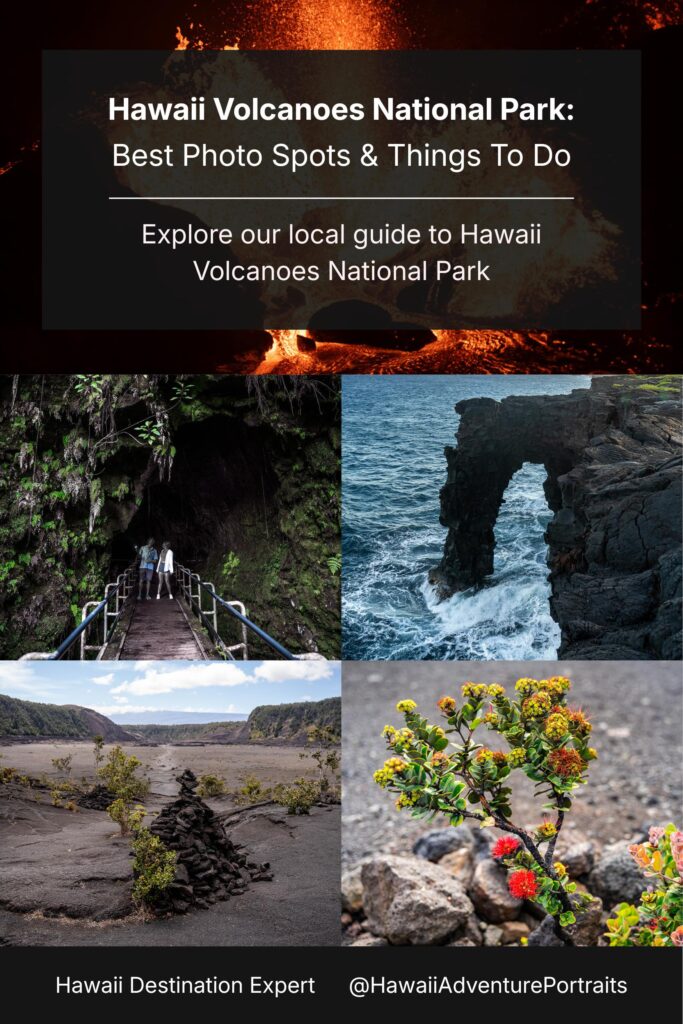
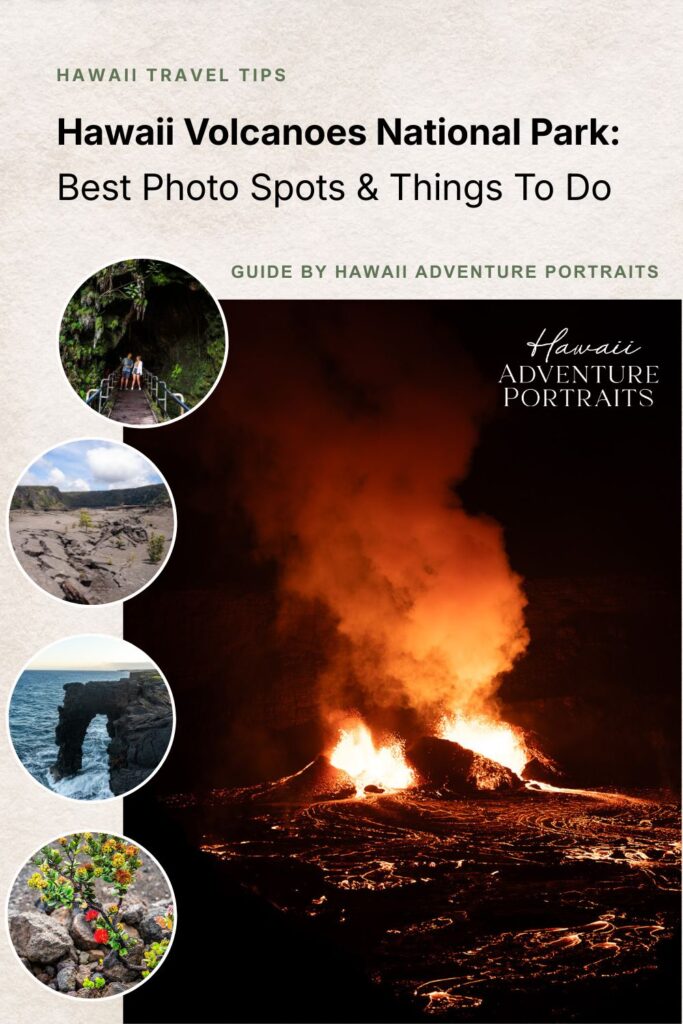
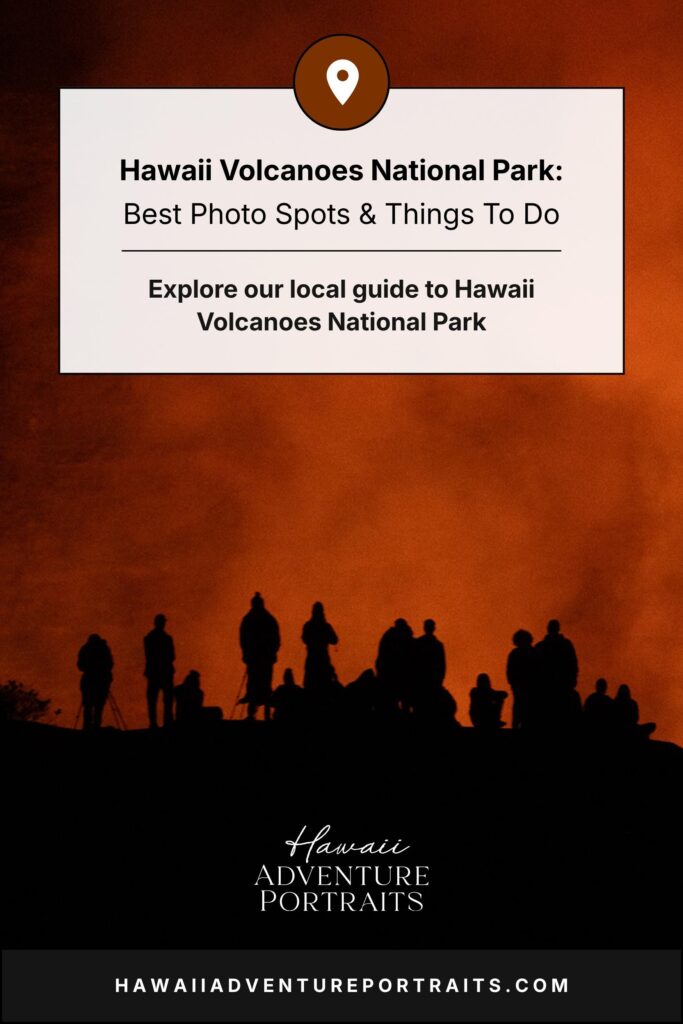
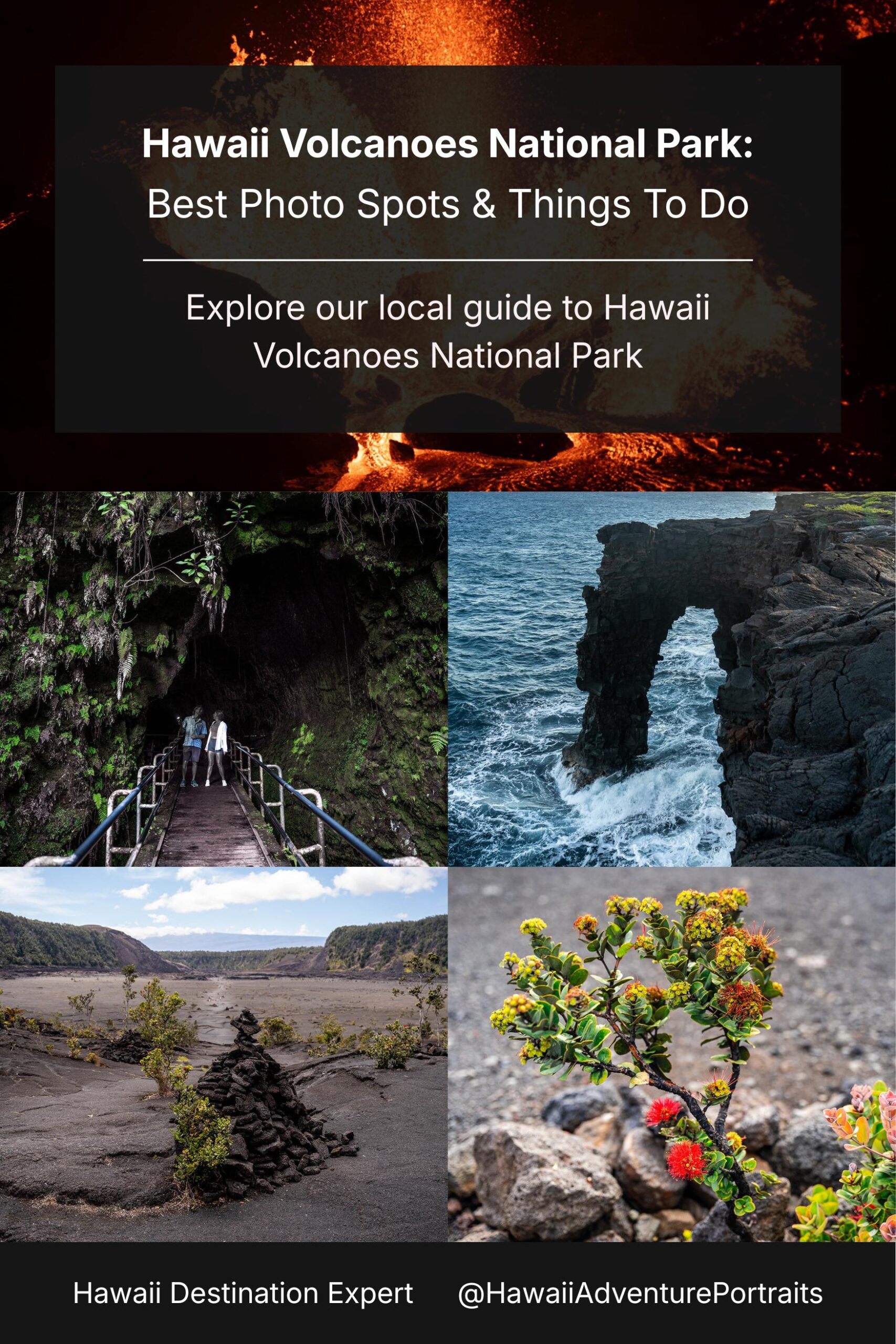
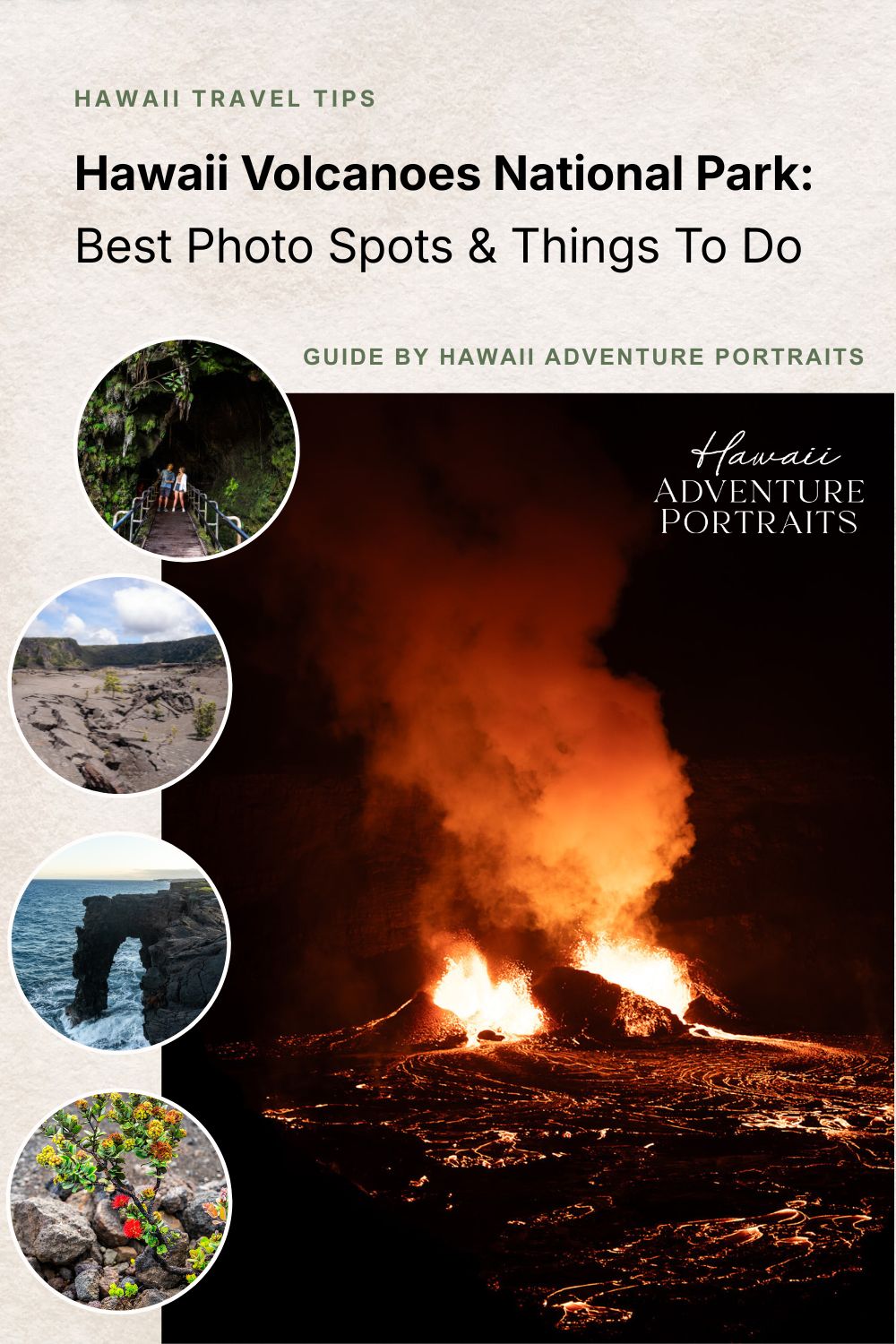
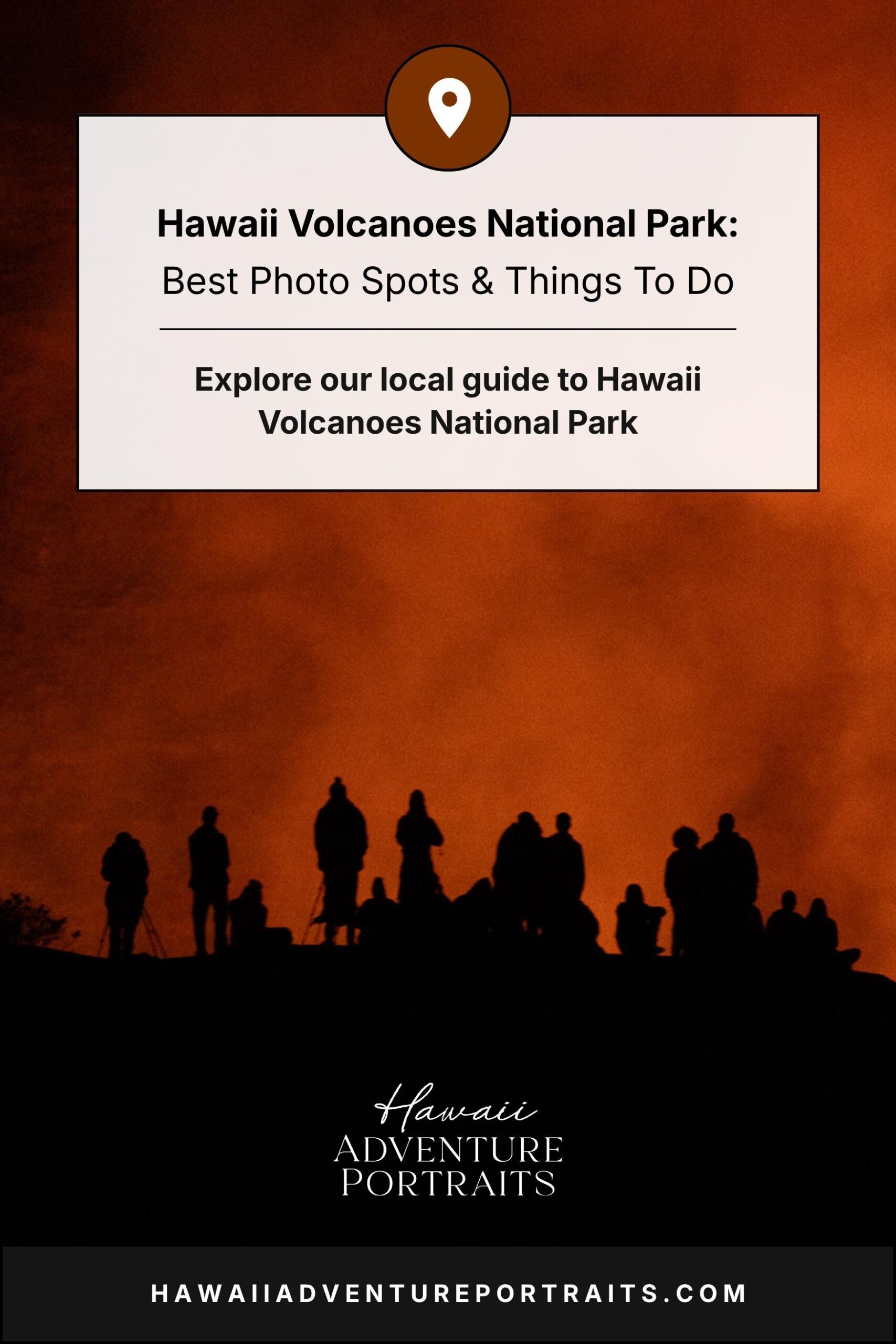
Meet Christian
Hawaii Wedding and Portrait Photographer on The Big Island, Oahu, Maui, and Kauai.
Seamless sessions in breathtaking settings, designed for those who want vibrant, wall-worthy images.
The Big Island Adventure Guide
Free Download
Creating photography experiences as vibrant and unforgettable as your time in Hawaiʻi. Crafted with care and framed by adventure.
Big island based photographer capturing memories across Hawaiʻi including Oahu, Maui, and Kauai.
Explore
Services
Big island, Hawai'i Adventure Guide
Our curated guide is your key to an incredible week on the Big Island. Complete with discounts from our local partners. Get a dozen free recommendations when you download the guide, or book a session with us and you’ll get it all for free.
COPYRIGHT © 2025 HAWAII ADVENTURE PORTRAITS™️
Site Design by Palme Design Co.
Follow us On Instagram
